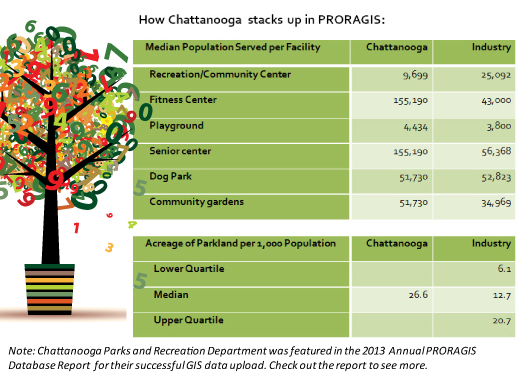PRORAGIS – NRPA’s user-driven park and recreation database and benchmarking tool—is helping park and rec pros use data to measure—measure their successes, check their weaknesses, and see how they compare to similar agencies. Last month, we chatted with the City of Chattanooga Parks and Recreation Department to learn more about their PRORAGIS experience. On the call, we had: Glenn Sheppard, Parks and Recreation Director; Larry Zehnder, Administrator; and David Johnson, Resource Manager. Below is an excerpt highlighting why Chattanooga participated and what they see as the essential value of PRORAGIS.
Q: What motivated Chattanooga Parks and Recreation to participate in PRORAGIS?
Larry Zehnder:Our department’s philosophy is, ‘If you can’t measure it, you can’t use it very well.’ Working under that perspective and because data is very important to successful management of our department, it was necessary that we participate in PRORAGIS. Now, with more cities and counties getting involved, PRORAGIS is becoming more and more useful. It will continue to become so much more valuable with greater participation.
Glenn Sheppard: We realized that PRORAGIS gives us a tool to conduct comprehensive benchmarking. We can look at the data to determine who is at the top and who is at the bottom – and where our department falls accordingly.
Q: How is PRORAGIS valuable to Chattanooga Parks and Recreation?
Larry Zehnder:Our objective is to bring quality of life to the city. We need documented evidence like we find in PRORAGIS to do that – data related to fiscal spending, staffing, and land management. This kind of information is very important to our elected officials and decision makers. And it helps our department answer the question, ‘Are we doing better than the national average?’
David Johnson: Having this data and being able to show how you compare to other agencies allows you to identify where you are weak and where you are strong. That information can be used to make the argument that you should get credit for the areas where you are strong and that you need additional resources for the areas in which you are weaker. When policymakers have to make decisions about where to allocate resources it is good to know where you stand and have the data to support that.
Q: Describe your experience using PRORAGIS and uploading data:
David Johnson: The way that the data is collected in PRORAGIS is straightforward, but you do have to work with other people in order to complete it. You have to reach out to others who have greater familiarity with certain aspects of the field to see what data and resources are available to complete the profile. Identifying the right individuals to answer the right questions will speed up the time required to complete a profile.
Q: How has your department successfully used the data in PRORAGIS?
Larry Zehnder: Currently, we are in the process of updating our comprehensive master plan and the data that we’ve submitted into PRORAGIS will be a part of that plan. It will also be helpful to review data submitted by others when preparing our plan. With PRORAGIS, we have this unique opportunity to look at the data and evaluate whether our perceptions are correct. We have sometimes found that the numbers challenge our assumptions. The ability to benchmark against other participants allows us to set goals more realistically and the more departments that participate, the more valuable of a tool it will be for making important decisions.
Does your agency use data to drive decisions or planning? Why is data and benchmarking so important for parks and recreation? Learn about Park Metrics.
Compiled by: Hayley Jackson, Research Specialist, NRPA


